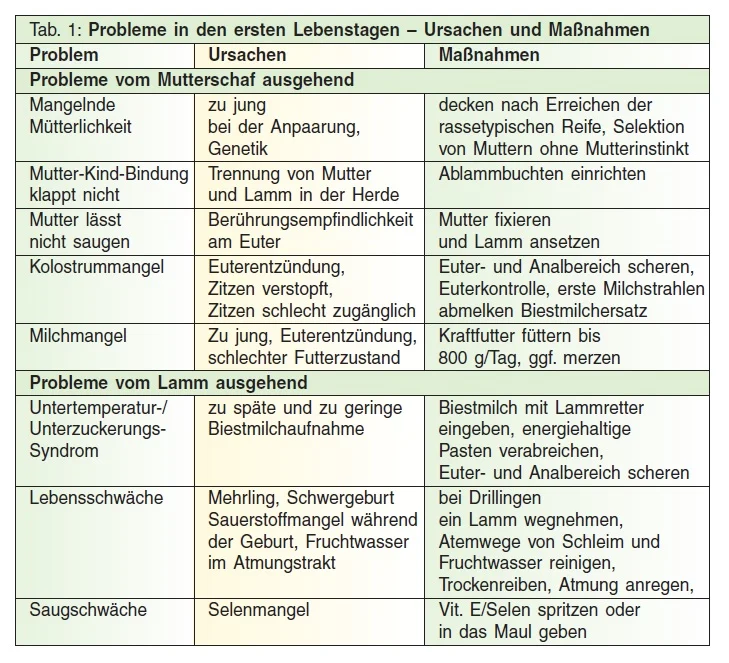16/01/2024
Problem lambs - what to do?
Source: landwirt.com
Every lamb lost means that a ewe has been fed for months without being paid.
The aim of economic sheep farming is to achieve a rearing rate of 1.5 lambs per ewe per year. Monitoring lambing and ensuring that lambs are optimally cared for increases the profitability of sheep farming. Knowledge of the causes and preventive measures are needed to reduce lambing losses (Table 1). If problems occur, it must first be clarified whether they originate from the ewe or the lamb itself.

Biestmilch within 4 hours
Biestmilch should always be administered within the first four hours of life. Later on, the immune substances in Biestmilch can no longer be absorbed in the intestines. The lambs are then more susceptible to diseases because their own immune system is only slowly being built up.
There are various ways to ensure the supply of immunoglobulins in the event of a Biestmilch deficiency:
- Use fresh or frozen colostrum reserves from a previously lambed sheep. Thaw the colostrum slowly. A water bath is well suited. In practice, it is also defrosted in the microwave - here too, it is important to defrost at low power (defrost mode, maximum 250 watts) and for an appropriate length of time.
- Biestmilch from cows can also be fed to the lambs. This can be obtained cheaply from most dairy cow farms.
- Practitioners also report good experiences with Biestmilch substitute as a ready-made product. The powder is mixed with warm water according to the manufacturing instructions.
Drinking with milk substitute
If there is a lack of milk, the mother's milk yield can often be increased by giving concentrated feed. If this is not successful, a replacement feed is necessary. This can be cow's or goat's milk or milk replacer suitable for lambs. The concentration of the drinker is 200 g milk powder per liter. Initially, the lambs are suckled with a feeding bottle. The drinking temperature should be between 35 and 40° C. If the drink is too cold, it cannot be sufficiently thickened in the abomasum, which means that the milk ingredients enter the intestine undigested. This causes diarrhea. As soon as the lambs suckle quickly, they can be watered in the group at the teat bucket with several teats. Clean drinking bowls are a basic requirement for rearing with replacement drinkers. The basic principle of the feeding schedule is: increasing quantities with decreasing feeding frequency. The amount of feed per day is increased from 300 ml to 1,500 ml and the frequency of feeding is reduced from six times a day to twice a day (Table 2).
From the second week of life, dry feed in the form of good hay and lamb grain can be offered to develop the forestomach system. If eaten well, water can be given from the sixth week of life.

Weak and lazy
Particularly with late-maturing breeds, mating too early often means that the young mother is not yet mentally capable of raising lambs in a caring manner. It is important to prevent the mother from losing track of her lambs during the imprinting phase, especially in the case of multiple births. The mother-child relationship is best established in the lambing pen. The mother should be brought into the single pen before the birth. Exclude older sheep that do not accept lambs from breeding. Sometimes restraining the mother and selectively attaching the lambs promotes acceptance. However, the cause of high loss rates does not always lie with the ewe. Problem lambs are often weak or drink poorly. As an immediate measure, care should be taken to ensure an adequate supply of important vitamins and minerals. There are special food supplements on the market to increase the vitality of newborn lambs. Important ingredients include vitamins A, D and E, as well as selenium, ß-carotene and lecithin as energy sources. A common cause of suckling weakness is selenium deficiency. Germany is a selenium deficiency area. Even in large parts of Austria, the basic feed does not provide enough selenium to cover the sheep's requirements. To prevent this problem, mineral supplements for ewes are a must. A vitamin E/selenium preparation must be administered in the event of acute suckling weakness. Oxygen deficiency after heavy, long births or posterior deliveries is a serious risk for lambs. Systematic birth monitoring and, if necessary, obstetric care can help here. Sterile latex gloves are used during interventions. Mucus and amniotic fluid can be ejected from the respiratory tract by carefully swinging the lamb by its hind legs. The respiratory center can be activated by cold water or stimulation with a straw in the nose. Dry licking, rubbing with straw and massages support the process. Due to their small mass, lambs cool down very quickly when exposed to wind and cold. In this situation, a supply of brown fatty tissue is used to produce heat. However, this supply only lasts for 18 hours. At the same time, blood sugar is consumed and the desire to suckle decreases. In addition to immunization, the rapid intake of a sufficient quantity of colostrum is also vital for maintaining body temperature. Hypothermic lambs must first be warmed up to 37 °C under a heat lamp. Milk can then be fed using the stomach tube (“lamb rescuer”). This also applies to lambs that show little or no sucking reflex. The milk is administered directly into the stomach. Lamb savers can be bought ready-made in stores or made up yourself from a large syringe without a needle (50-100 ml), a bladder catheter and some cooking oil as a lubricant. The quantities administered are 50 ml. It is essential that you ask a vet or an experienced shepherd to show you how to use the product. If not handled properly, there is a risk of injury to the airways. In severe cases, an additional glucose infusion by the vet is helpful.
You can find all products on this topic here: Animal husbandry!
